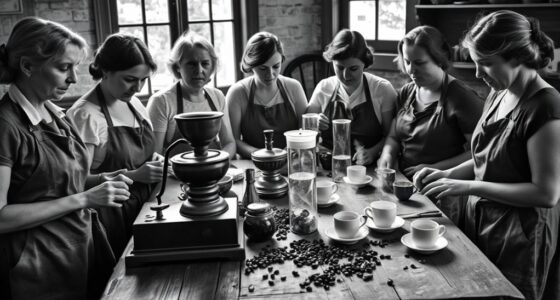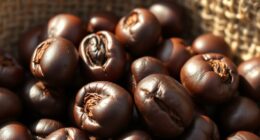You’ll find that coffee terms like espresso, Americano, and macchiato have fascinating origins rooted in culture and history. Espresso comes from Italy, highlighting a concentrated brewing method, while Americano was shaped during WWII when American soldiers added hot water to espresso. Macchiato, meaning “stained” in Italian, describes espresso with milk. Exploring these names reveals stories of craftsmanship and tradition—keep exploring to discover the full history behind each beloved term.
Key Takeaways
- “Espresso” originates from Italy, named after the quick, high-pressure brewing method used to produce a concentrated shot.
- “Americano” has roots in WWII, where American soldiers diluted espresso with hot water for a milder taste.
- “Macchiato” means “stained” in Italian, describing espresso with a small amount of frothy milk added.
- Coffee terms often reflect cultural, historical, and regional influences shaping the language of coffee.
- The names embody brewing techniques, historical events, and cultural exchanges that evolved over centuries.

The rich vocabulary surrounding coffee has fascinating roots that trace back to its history and global journey. When you explore the origins of terms like espresso, Americano, and macchiato, you uncover stories rooted in different cultures and brewing practices. These words not only describe specific drinks but also reveal insights about brewing techniques and coffee plant varieties that shaped the way we enjoy coffee today. For example, the term “espresso” comes from Italy and refers to a brewing technique that uses high pressure to produce a concentrated shot of coffee. This method emphasizes extraction speed and precision, highlighting the importance of specific coffee plant varieties that respond well to such techniques. Arabica and Robusta, the two main coffee plant varieties, each lend different qualities to espresso shots—Arabica offering nuanced flavors and lower caffeine, while Robusta provides a stronger, more bitter profile. Understanding these varieties helps you appreciate why espresso has a rich, bold taste and how brewing techniques influence its final profile. Additionally, the coffee brewing process plays a critical role in shaping the flavor profile of espresso, emphasizing the importance of technique and equipment.
Exploring coffee terms reveals rich stories of culture, brewing techniques, and plant varieties shaping our favorite drinks today.
Similarly, the word “Americano” has roots tied to history and cultural adaptation. During World War II, American soldiers in Europe would dilute espresso with hot water to mimic the milder coffee they were used to back home. This simple addition transformed a concentrated shot into a more familiar, larger beverage. The technique of adding water to espresso showcases how brewing methods can evolve based on taste preferences and cultural influences. You can see how the choice of coffee plant varieties plays a role here too—the strength and flavor of the original espresso, which varies depending on the beans used, impact the final taste of an Americano. Whether made from a blend of Arabica beans or a mix that includes Robusta for extra body, the base coffee sets the stage for this dilution process.
The term “macchiato” originates from Italy as well and means “stained” or “spotted.” It describes an espresso “stained” with a small amount of frothy milk. This drink’s creation is tied directly to brewing techniques—adding milk to modify espresso’s intensity and texture. The milk used can come from different coffee plant varieties, affecting the overall flavor balance. For instance, milk from cows grazing on different grasses or processed in various ways can subtly influence the taste, although the primary impact comes from the espresso itself. When you order a macchiato, you’re experiencing a simple yet elegant variation of brewing technique, where the focus remains on the quality of the coffee and how it’s combined with milk from different sources. Additionally, the variety of brewing methods used across cultures influences how these drinks are prepared and enjoyed worldwide.
In essence, these terms are more than just names; they encapsulate the story of brewing techniques and the diversity of coffee plant varieties. They reflect centuries of cultural exchange, technological innovation, and the natural diversity found in coffee plants. As you learn their origins, you gain a deeper appreciation for the complex history behind each sip and the craftsmanship that goes into every cup.
Frequently Asked Questions
How Did Espresso Become the Standard Coffee Brewing Method Worldwide?
You might wonder how espresso became the standard coffee brewing technique worldwide. Its popularity grew because it offers a rich, intense flavor quickly, fitting busy lifestyles. As a result, espresso influenced global coffee terminology, shaping many coffee cultures. Its efficiency and bold taste made it a preferred method, leading to widespread adoption. Today, espresso stands as a cornerstone of coffee brewing techniques, defining the global coffee scene.
Are There Regional Variations in Coffee Terminology Beyond Italy and America?
You’ll find regional variations in coffee terminology worldwide, influenced by local dialects and adaptations. In different countries, you might hear unique names for drinks or methods that reflect local culture. For example, some places call a flat white differently, or have special terms for traditional brewing styles. These local adaptations enrich coffee culture globally, making it more diverse and interesting as each region adds its own flavor to the language.
What Are the Historical Influences Behind the Naming of Coffee Drinks?
You’re curious about the historical influences behind coffee drink names. Cultural influences on coffee naming reflect how different societies have shaped their drinks, often influenced by historical trade routes that spread coffee and its terminology worldwide. These routes facilitated the exchange of ideas, leading to diverse names like espresso and macchiato. Over time, regional variations emerged, blending local language and customs, creating the rich tapestry of coffee terminology you enjoy today.
How Have Coffee Terms Evolved With Modern Coffee Culture?
Did you know that over 60% of coffee drinkers use coffee slang daily? Modern coffee culture constantly evolves, shaping new terms and trends. As you explore new brews, you’ll notice how coffee slang adapts, blending traditional names with innovative twists. This evolution reflects coffee’s global influence and your growing appreciation for unique coffee experiences. Staying updated on modern coffee trends helps you connect and enjoy your favorite drinks even more.
Do Different Countries Have Unique Names for Similar Coffee Preparations?
You’ll notice that different countries often have unique names for similar coffee preparations due to cultural naming differences and regional coffee lexicons. For example, what’s called a “café solo” in Spain is a single shot espresso, while in Italy, they simply call it “espresso.” These regional terms reflect local traditions and preferences, making coffee culture diverse worldwide and showing how language shapes our coffee experiences.
Conclusion
Now that you know the stories behind these coffee terms, you can savor each sip with a new appreciation. Imagine yourself in a bustling Italian café, the aroma of rich espresso filling the air, or in a quiet American diner, sipping a smooth Americano. These words aren’t just menu items—they’re snapshots of history, culture, and tradition. Next time you order, remember the journey behind each cup, turning your coffee break into a story worth tasting.









